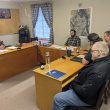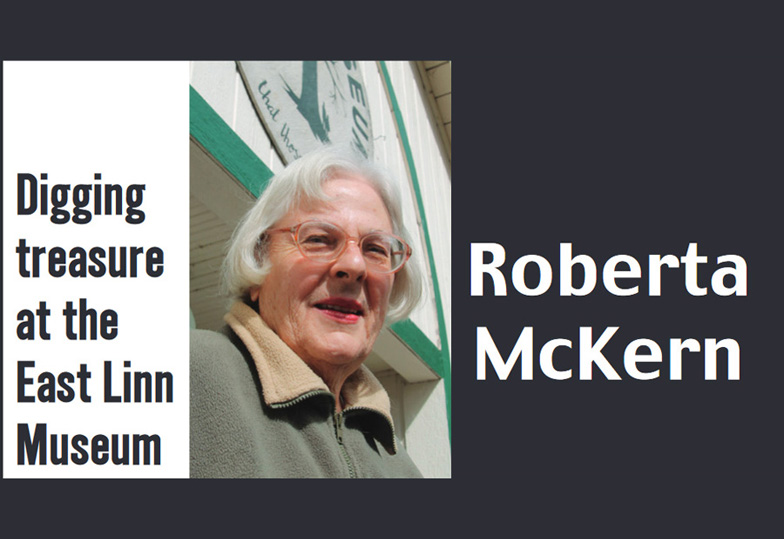“Go talk to Lynn Rice,” a pair of East Linn Museum volunteers were advised after expressing an interest in collecting stories about disappearing area mills.
So Mike Sele and Glenda Hopkins did just that, enriching the museum’s resource room with the interview in 2005.
Lynn began their session by trying to remember as many mills as he could, reaching between 20 and 30, depending on whether portable mills counted. He also threw in interesting autobiographical details of his younger years and his work as a sawmill man.
When we look at his background, Lynn seemed destined for some angle of the lumber business. He was born near Holley on the Calapooia River in 1910 to Clifford Guy and Jenny Mabel Rice, who named their child James Lynn after his pioneer grandfather, James Norval. Like his namesake, the new arrival went by James, which, like Norval, appears frequently in the family’s history.
Clifford worked in logging when timber was harvested on the Calapooia River’s north bank. The river had been dammed a few miles upstream from Lynn’s birthplace to form a log-collecting lake. Once released, its cargo floated to Crawfordsville to an early sawmill, where a boom ended that journey. In later years, Jenny Rice spoke of hearing the logs thud against the Calapooia’s cut banks as they traveled downstream.
Before his marriage, Clifford had been driving a span of three mules hauling a log to the lake when he got too close to the ridge’s brow. When the log began going downhill, he thought the mules were doomed. Luckily, he managed to turn the log and get it into the lake.
Another of Lynn’s parents’ recollections involved the Mealey Mill east of Foster on the Santiam River. One of its owners, Bill Mealey, was married to Jenny’s sister, Fannie.
Clifford logged for the last time the mill was run. Mealey and his brother, Judd, were hauling logs into the mill with a steam donkey, and Clifford thought he could bring in two or three at a time if the skid road was watered. So he had Lynn’s older brother, Melvin, go ahead with a horse and a stand with a barrel watering the path. Shortly afterward, the mill’s steam boiler was moved to Sweet Home.
Lynn had a story, too, about Hans Wodtli’s mill at Foster. As we know, it sawed lumber, ground grain and generated electricity for Foster and Sweet Home area customers based on waterpower from Wiley Creek.
The electricity’s hours followed Wodtli’s schedule, from when he activated the generator then turned it off before retiring at around 9 p.m. One night Lynn’s older sister, Clentha, was at a cousin’s party. Everyone was having a good time, resulting in a telephone call to the Wodtlis shortly before the shutoff. After much begging, the curfew was extended to 11.
Grandpa James was a founding member of the Pioneer Picnic Association, which was established in Crawfordsville but later moved to Brownsville. The picnic was a treat for young Lynn and his five siblings. Lynn recalled it as quite the trip: a nine-mile journey by horse and buggy, or horse and hack, or horse and rider, with the need to return home for evening chores. With luck, the kids would get a nickel after lunch for the picture shows — silent movies — something they didn’t get to see regularly.
Lynn thought he’d visited Sweet Home only once or twice before starting high school in the city in 1925. Not every kid attended then, partly because of transportation. Lynn rode to school with the Rapp twins, Floyd and Lloyd, whose father, Peter, bought them a Ford Model T touring car. However, at least one of the Rapps had to learn how to drive, so Lynn’s older brother instructed Floyd in the art.
As Lynn observed, you should never tell a novice driver not to hit something, because he or she will do it every time. Case in point: a poor cow resting on a gravel road on a hill above Holley. “Don’t hit that cow,” came the obvious warning as the car approached her side. But the driver kept going. Hopefully, the animal survived.
The next year, Peter Rapp bought a new ’26 Chevrolet so that he and the twins, as well as a girl with vehicle access, could take turns driving.
At around this time, Lynn’s cousin Norval was building a sawmill where the Weddle Bridge in Sankey Park now stands in Sweet Home. This was Rice Lumber Company, where Lynn went to work in 1932. By then the Oregon Electric railroad had run a spur line up the Calapooia to Dollar Camp. Its entry into timber country really opened the lumber industry, but it took a while for everything to move into gear.
In 1934, Norval traded Rice Lumber Company to a Corvallis man, John McCready, and his two sons, Clarence and Lloyd, for a 600-acre ranch near Amity.
“He wanted to get out, anyway,” Lynn said of his cousin. “It wasn’t very profitable. Logs were hard to get. Lumber wasn’t worth anything. I worked many days for $1 a day.”
He stayed at the mill, which the McCreadys changed from a steam valve to electricity.
That year also saw the arrival of Fred Powers and Thomas Davis from Powers, Oregon. The two had a contract to receive lumber from the Hill family company, and with it they founded Santiam Lumber Company.
Lynn worked seven months there at request. The superintendent, himself a McCready, borrowed him for a time while a rachet setter recovered from an eye injury inflicted by a ball of bark dust.
(What was a rachet setter, you may ask? Lynn explained it thusly: A sawyer would give a signal to set a log cut to two inches or more, then the rachet setter riding the saw carriage would do just that.)
Lynn had another cousin who was going to saw, and he refused to do it unless Lynn set the ratchets. So Lynn returned to the McCreadys. They wanted to try a night shift again — which Lynn had worked earlier — after having experienced trouble with one.
The mill burned down. By the mid-1930s, some aspects of President Franklin D. Roosevelt’s New Deal had gone into action to alleviate the plight of workers affected by the Great Depression, which had set in after the stock market crash of 1929.
One feature was welfare for those in dire need, known as the “dole.” Industry unionization and workman’s compensation were part of it, as was Social Security. After losing work at McCreadys because of the mill fire, Lynn and the other employees received $25 a week in workman’s comp — or “rocking chair,” as it was called.
It occurred to the men that they could rebuild the mill and return to work, if they had the material, which the McCreadys said they could supply. So Lynn and a committee formed a plan and took it to the workman’s comp office in Salem.
The idea seemed acceptable until they reached the official at the top. “Ah, we can’t do that,” this man told the committee, according to Lynn. “No way can we do that. That would just open things up that a sawmill out here wanted a bunch of repair work, they’d shut it down. The men would draw their unemployment and do the work for them.” (That had been the idea, of course.) So the great plan ended.
McCready took over a small mill down near a shingle mill instead. It had no lights, despite running on electricity. Kerosene lanterns were hung to accommodate a night shift. Did it work? “We ran that mill one night by kerosene lantern,” Lynn said. “Well, we could see, I guess — a little, anyhow.”
Meanwhile, as Lynn saw it, the McCreadys got behind the eight ball. They weren’t paying what they owed for worker’s compensation. They took money from the men’s wages. They were supposed to pay a matching amount on their part but failed to do so.
Workman’s comp was a new idea then, and a lot of employers regarded it as an imposition. In general, many conservatives saw the New Deal as anathema, giving funds to people who should be able to pull themselves up through their own labors. But jobs were hard to find in the 1930s.
The demands of the workman’s comp requirements were hard on the McCreadys. As a sign of financial trouble, they offered Lynn and the others a chance to buy preferred stock. Lynn, however, was among those who did not trust it. A workman’s comp lawyer wrangled with the McCreadys, and the mill was taken over.
The McCreadys were going out, but Lynn still had back wages coming. He was building his house, and he knew McCready lumber had been going to a customer with sash and door factories in Albany and Portland. So he took a list of necessary materials for window openings and door frames to Vance McCready, then still in the office. Could he get this instead of the owed wages? “Sure,” came the reply. About a week later, Lynn picked up the building supplies in his four-wheeled trailer.
Lynn wanted to tell the interviewers a story about his brother-in-law and back wages. Generally, this man worked for the forestry department, but when weather closed the woods in winter, he’d work at a small sawmill near Cascadia. But no money.
When he arrived at work one day, he saw a new saw blade on the arbor being held in place by the collar and a nut. He removed the nut and the collar, then laid the collar down, picked up the nut and put it in his pocket. Then he pretended to search for the latter in vain. Finally, he said to the other men, “You get hold of (owner) Burt Smith. If he’s got my wages that I’ve got coming, I’ll give you back your nut.” He got his money, the mill resumed sawing, and he went home. If mill operators had their uncertainties in the ’30s, their men obviously had them as well.
Stu Weise took over the McCready mill and was, Lynn declared, the best of all his bosses. Weise kept him deferred all through the war, and Lynn stayed 10 years with him. (Lynn doesn’t say so, but the dates indicate that this was WestGate Lumber.)
At the time of the takeover, the sawyer was of the “old school,” cutting logs any way he could and quickly. This bothered Stu. “How do you want it sawed?” the sawyer asked. Stu wasn’t sure, but he knew it wasn’t this way. So out the sawyer went, replaced by a younger man.
“He wasn’t a sawyer,” Lynn held. “He was a butcher.”
Johnny, the new sawyer, was a fast worker who’d come in every morning and have lumber all over by 8:30 a.m. The mill was cleaned out every evening in case of fire, and with so much lumber stacked around, it was hard to get anywhere.
Sawing, Lynn said, was an art. Sawyers had to read logs as best as they could while watching out for knots and rocks. The best wood was on the outside. One didn’t just stick a log on a carriage and cut any which way.
Johnny came in one day after a full night with two or three women and several jugs of whiskey, in Lynn’s estimation. He could barely walk, so he asked Lynn to saw for him while he slept it off.
Stu would come out of the office occasionally, check the green chain and visit the men pulling lumber. He knew how to judge lumber. He’d approach the grader, and, as Lynn recalled, two-thirds of the time, if he was sawing, everything was full and hard to get off. Stu would come up to the resaw and the edger man and the head rig.
Everything was going fine this morning. “What’s going on?” he asked Lynn, surprised to see him sawing. Johnny was over yonder sleeping it off, Lynn explained.
That night Stu tapped Lynn as he started for home. “Starting at 6,” he announced, “you’re my sawyer.”
“Maybe I don’t want to be your sawyer,” Lynn replied.
“It doesn’t make any difference,” Stu fired back.
“Maybe I won’t make you any money,” Lynn said. “I probably can’t cut as much lumber as he does.”
“It doesn’t make any difference,” Stu resolved. “You’re going to saw.”
However, as Lynn recalled, he cut more than Johnny, raised the lumber 1½ grade and pleased the customers to the point of making reorders, which tickled the boss. That also meant they were making good lumber.
Lynn Rice was a dedicated worker who took pride in what he did. From his recollections, we can appreciate those who once labored in our area sawmills.
In our next installment, he works for Clear Lumber Company and gets fired.
We’re still preparing and taking donations for our expected yard sale beginning at 9 a.m. Friday and Saturday, July 14-15. The museum is ever in need of volunteers, and the museum will close July 1 for the July 4 weekend due in part to a lack of them.





